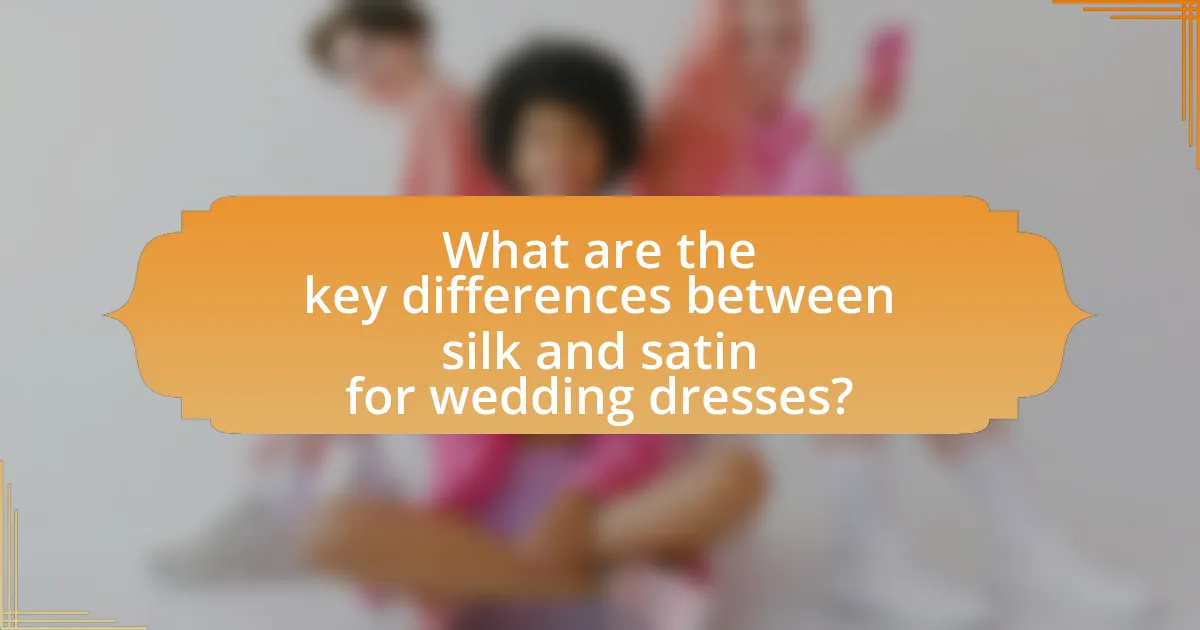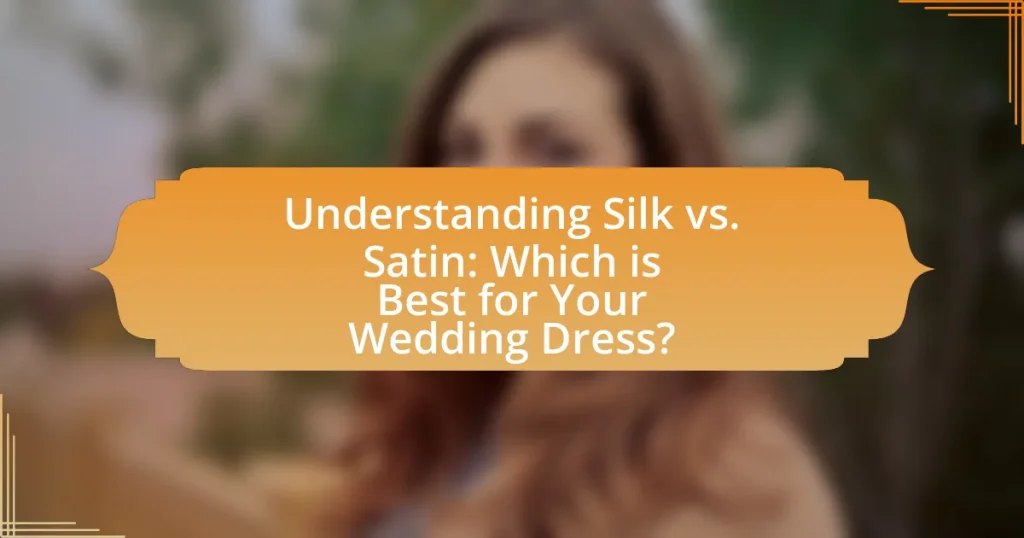The article focuses on the key differences between silk and satin as fabrics for wedding dresses, highlighting their composition, texture, and overall aesthetic qualities. Silk, a natural fiber known for its luxurious feel and breathability, offers a soft drape and elegant sheen, making it ideal for flowing silhouettes. In contrast, satin, characterized by its glossy surface and structured appearance, can be made from various fibers, including polyester and silk, and is generally more affordable and easier to maintain. The article also discusses the advantages and disadvantages of each fabric, their care requirements, and how factors such as budget and wedding theme influence the choice between silk and satin for bridal attire.

What are the key differences between silk and satin for wedding dresses?
Silk and satin differ primarily in their composition and finish, impacting their appearance and feel in wedding dresses. Silk is a natural fiber produced by silkworms, known for its luxurious texture and breathability, while satin is a weave that can be made from various fibers, including polyester and silk, characterized by its glossy surface and smooth drape. Silk wedding dresses often have a more organic look and feel, providing a soft, flowing silhouette, whereas satin dresses tend to have a more structured appearance due to their heavier weight and sheen. Additionally, silk is generally more expensive and requires more delicate care compared to satin, which is often more affordable and easier to maintain.
How do the materials of silk and satin differ?
Silk and satin differ primarily in their composition and weave structure. Silk is a natural fiber produced by silkworms, while satin refers to a specific weave that can be made from various fibers, including silk, polyester, or nylon. The satin weave creates a glossy surface on one side and a dull finish on the other, regardless of the fiber used. In contrast, silk has a natural sheen and softness due to its fiber structure. This distinction is crucial for applications like wedding dresses, where the choice between the two can affect the garment’s drape, texture, and overall appearance.
What is silk made from and how is it produced?
Silk is made from the protein fibers produced by silkworms, specifically the larvae of the Bombyx mori moth. The production process involves cultivating silkworms on mulberry leaves, allowing them to spin cocoons made of silk fibers. Once the cocoons are formed, they are harvested and boiled to kill the pupae, which allows the long silk threads to be unwound. This method of silk production has been practiced for thousands of years, with historical records indicating that sericulture, the cultivation of silkworms, began in China around 2700 BCE.
What is satin and what materials can it be made from?
Satin is a type of weave that produces a smooth, glossy surface on one side and a dull finish on the other. It can be made from various materials, including silk, polyester, nylon, and acetate. The choice of material affects the fabric’s drape, sheen, and overall quality, with silk satin being the most luxurious option due to its natural fibers and softness. Polyester satin is more affordable and widely used in fashion, while nylon and acetate offer different textures and finishes.
What are the characteristics of silk as a fabric?
Silk is a luxurious fabric known for its smooth texture, natural sheen, and lightweight properties. It is composed of protein fibers produced by silkworms, which contribute to its softness and drape. Silk is also highly breathable, allowing for comfort in various temperatures, and has a natural ability to absorb moisture, making it suitable for formal wear. Additionally, silk exhibits excellent color retention and vibrancy, enhancing its aesthetic appeal. The fabric is also strong yet delicate, requiring careful handling to maintain its quality.
How does silk’s texture and sheen affect its appearance in wedding dresses?
Silk’s texture and sheen significantly enhance the appearance of wedding dresses by providing a luxurious and elegant look. The smooth, soft texture of silk drapes beautifully, creating a flattering silhouette that complements various body shapes. Additionally, the natural sheen of silk reflects light in a way that adds depth and dimension to the fabric, making the dress appear more vibrant and visually appealing. This combination of texture and sheen is often associated with high-quality garments, which is why silk is a popular choice for wedding dresses, as it conveys sophistication and timeless beauty.
What are the advantages of using silk for wedding dresses?
Silk offers several advantages for wedding dresses, including its luxurious feel, natural sheen, and breathability. The luxurious texture of silk enhances the overall elegance of a wedding dress, making it a popular choice among brides. Additionally, silk has a natural luster that reflects light beautifully, contributing to a stunning visual appeal. Its breathability ensures comfort throughout the wedding day, allowing for better temperature regulation compared to synthetic fabrics. Furthermore, silk drapes exceptionally well, creating flattering silhouettes that enhance the bride’s figure. These qualities make silk a favored fabric for creating timeless and sophisticated wedding attire.
What are the characteristics of satin as a fabric?
Satin is a fabric known for its smooth, glossy surface and luxurious feel. This characteristic is due to its weave, which typically involves a high thread count and a combination of fibers such as silk, polyester, or nylon. Satin’s sheen is a result of the way light reflects off its surface, making it a popular choice for formal wear and evening gowns. Additionally, satin drapes beautifully, allowing it to create elegant silhouettes, and it has a soft texture that enhances comfort against the skin. Its durability varies depending on the fiber content, with silk satin being more delicate compared to polyester satin, which is more resilient.
How does satin’s texture and finish compare to silk?
Satin has a smooth, glossy finish on one side and a duller texture on the reverse, while silk is naturally soft, luxurious, and has a consistent sheen throughout. The texture of satin can feel slightly heavier and less breathable compared to silk, which is known for its lightweight and breathable qualities. Satin is often made from synthetic fibers, which can affect its overall feel and drape, whereas silk is a natural fiber that provides a more elegant and fluid drape. This distinction in material composition contributes to the differences in texture and finish, making silk generally more desirable for high-end garments like wedding dresses due to its luxurious feel and appearance.
What are the benefits of choosing satin for wedding dresses?
Choosing satin for wedding dresses offers several benefits, including its luxurious appearance, smooth texture, and durability. Satin has a glossy finish that enhances the overall elegance of a wedding dress, making it visually appealing in photographs and during the ceremony. The fabric’s smooth surface feels comfortable against the skin, reducing irritation for the wearer. Additionally, satin is known for its strength and resilience, allowing it to maintain its shape and structure throughout the event. This durability ensures that the dress can withstand movement and wear, making it a practical choice for a long day of celebrations.

How do silk and satin impact the overall look and feel of a wedding dress?
Silk and satin significantly influence the overall look and feel of a wedding dress by providing distinct textures and appearances. Silk offers a luxurious, natural sheen and a soft drape that enhances the elegance of a gown, making it ideal for flowing silhouettes. In contrast, satin, which is typically made from silk or synthetic fibers, has a glossy surface that reflects light beautifully, creating a more structured and formal appearance. The choice between these fabrics can affect not only the aesthetic but also the comfort level; silk is breathable and lightweight, while satin can feel heavier and less breathable. This distinction is crucial for brides when selecting a dress that aligns with their desired style and comfort on their wedding day.
What aesthetic qualities do silk and satin bring to wedding dresses?
Silk and satin bring luxurious aesthetic qualities to wedding dresses, enhancing their elegance and visual appeal. Silk offers a natural sheen and soft drape, creating a fluid silhouette that flatters various body types. Satin, with its glossy surface and smooth texture, adds a sophisticated shine that catches light beautifully, making it ideal for formal occasions. Both fabrics contribute to a romantic and timeless look, with silk providing a more understated elegance and satin delivering a bold, glamorous effect. The choice between them can significantly influence the overall aesthetic of the wedding dress, aligning with the bride’s personal style and the wedding theme.
How does the drape of silk enhance the design of a wedding dress?
The drape of silk enhances the design of a wedding dress by providing a luxurious, flowing silhouette that flatters the body. Silk’s natural weight and softness allow it to fall gracefully, creating elegant lines and movement that elevate the overall aesthetic of the gown. Additionally, silk’s ability to hold shape while also being lightweight contributes to a refined look, making it a preferred choice for intricate designs and detailed embellishments. This is supported by the fact that silk has a unique fiber structure that reflects light beautifully, adding a subtle sheen that enhances the visual appeal of the dress.
In what ways does satin contribute to the structure of a wedding dress?
Satin contributes to the structure of a wedding dress by providing a smooth, luxurious finish that enhances the overall silhouette. The fabric’s weight and drape allow for elegant shaping, which is essential for creating structured designs like ball gowns or A-line dresses. Additionally, satin’s stiffness can help maintain the dress’s form, ensuring that it holds its shape throughout the event. The reflective quality of satin also adds visual depth, making the dress appear more dynamic under various lighting conditions.
How do silk and satin affect comfort and wearability?
Silk and satin significantly enhance comfort and wearability due to their smooth textures and breathable properties. Silk, a natural fiber, is known for its softness and ability to regulate temperature, making it comfortable against the skin in various climates. Satin, often made from synthetic fibers, offers a glossy finish and a luxurious feel, which can also contribute to comfort, though it may not be as breathable as silk. Studies indicate that silk can absorb moisture better than satin, which can lead to increased comfort during extended wear. Therefore, while both fabrics provide a sense of luxury, silk generally offers superior comfort and wearability due to its natural properties.
What are the breathability and weight differences between silk and satin?
Silk is more breathable and lighter than satin. Silk, a natural fiber, allows air to circulate, making it ideal for warm weather and comfort, while satin, often made from synthetic fibers, tends to trap heat and moisture, resulting in reduced breathability. Additionally, silk typically weighs less than satin due to its finer weave and lighter construction, contributing to a more delicate feel. This distinction is crucial for wedding dresses, where comfort and temperature regulation are important factors.
How do these fabrics perform in different weather conditions?
Silk and satin perform differently in various weather conditions. Silk is breathable and moisture-wicking, making it suitable for warm weather, as it helps regulate body temperature and keeps the wearer cool. In contrast, satin, which is often made from polyester, can trap heat and may feel less comfortable in high temperatures. In cooler conditions, silk retains warmth due to its natural fibers, while satin can provide a sleek, elegant look but may not offer the same insulation. Additionally, silk is more prone to damage from humidity and rain, whereas satin is generally more durable and resistant to moisture, making it a better choice for unpredictable weather.

What should you consider when choosing between silk and satin for your wedding dress?
When choosing between silk and satin for your wedding dress, consider the fabric’s texture, drape, and breathability. Silk is a natural fiber known for its luxurious feel and breathability, making it comfortable for all-day wear. Satin, often made from synthetic fibers, has a glossy finish and a heavier drape, which can create a structured silhouette. Additionally, silk tends to be more expensive and requires careful maintenance, while satin is generally more affordable and easier to care for. These factors will influence your decision based on your budget, comfort, and desired aesthetic for your wedding day.
What factors should influence your choice of fabric for a wedding dress?
The choice of fabric for a wedding dress should be influenced by factors such as comfort, drape, climate, and the desired aesthetic. Comfort is crucial, as the bride will wear the dress for an extended period; fabrics like silk offer breathability and softness. Drape affects how the dress falls and moves; satin has a heavier drape that can create a structured look, while silk tends to flow more freely. Climate plays a significant role; lighter fabrics are preferable for warm weather, whereas heavier materials may be suitable for cooler conditions. Lastly, the desired aesthetic should align with the fabric’s characteristics; silk provides a luxurious sheen, while satin offers a more matte finish. These factors collectively ensure that the wedding dress meets both functional and stylistic needs.
How does your wedding theme affect the choice between silk and satin?
The wedding theme significantly influences the choice between silk and satin due to their distinct textures and appearances. For instance, a classic or vintage wedding theme often favors silk for its luxurious and timeless quality, which aligns with traditional aesthetics. In contrast, a modern or minimalist theme may lean towards satin, as its sleek and shiny finish complements contemporary designs. Additionally, silk drapes beautifully, enhancing romantic themes, while satin’s smooth surface can enhance a chic, sophisticated look. This alignment of fabric choice with wedding themes ensures that the overall visual coherence of the event is maintained.
What is your budget and how does it impact your fabric choice?
Your budget directly influences your fabric choice by determining the quality and type of materials you can afford. For instance, silk is generally more expensive than satin due to its luxurious feel and production process, which can significantly impact the overall cost of a wedding dress. A budget of $1,000 may limit options to satin or lower-quality silk, while a budget of $3,000 or more allows for high-quality silk, enhancing the dress’s elegance and durability. This correlation between budget and fabric choice is crucial for achieving the desired aesthetic and quality in a wedding dress.
What are the care and maintenance considerations for silk and satin wedding dresses?
Silk and satin wedding dresses require careful handling to maintain their beauty and integrity. For silk, dry cleaning is recommended to avoid water stains and preserve its natural sheen, while satin can often be spot cleaned with a gentle detergent. Both fabrics should be stored in a cool, dry place, ideally in a breathable garment bag to prevent yellowing and damage from light. Additionally, avoid hanging silk dresses for long periods to prevent stretching; instead, lay them flat when possible. These practices are essential as silk is delicate and prone to damage, while satin, though more durable, can still be affected by improper care.
How should you clean and store a silk wedding dress?
To clean a silk wedding dress, it is recommended to take it to a professional dry cleaner who specializes in silk garments, as home washing can damage the fabric. Silk is delicate and can be easily affected by water, heat, and harsh detergents, making professional cleaning essential for maintaining its integrity.
For storage, the silk wedding dress should be kept in a cool, dark place, ideally in a breathable garment bag made of cotton or muslin to prevent yellowing and dust accumulation. Avoid plastic bags, as they can trap moisture and lead to mildew. Additionally, storing the dress flat in a box lined with acid-free tissue paper can help preserve its shape and prevent creasing.
What are the best practices for maintaining a satin wedding dress?
To maintain a satin wedding dress, it is essential to handle it with care, store it properly, and clean it appropriately. Satin is a delicate fabric that can be easily damaged, so avoid exposing it to direct sunlight and keep it away from sharp objects. When storing the dress, use a breathable garment bag to prevent dust accumulation and hang it on a padded hanger to maintain its shape. For cleaning, it is advisable to consult a professional dry cleaner experienced with satin fabrics, as home washing can lead to discoloration or damage. Regularly check for any stains or signs of wear, and address them promptly to preserve the dress’s quality.
What tips can help you make the best choice for your wedding dress fabric?
To make the best choice for your wedding dress fabric, consider the characteristics of silk and satin. Silk is known for its luxurious feel, natural sheen, and breathability, making it ideal for warm weather, while satin, a weave rather than a fiber, offers a glossy finish and a heavier drape, suitable for structured designs. Evaluate the dress style you desire; for flowing gowns, silk may enhance movement, whereas satin can provide a more formal look. Additionally, consider the fabric’s weight and how it will drape on your body, as this affects comfort and appearance. Lastly, factor in your budget, as silk typically costs more than satin, influencing your overall choice.



